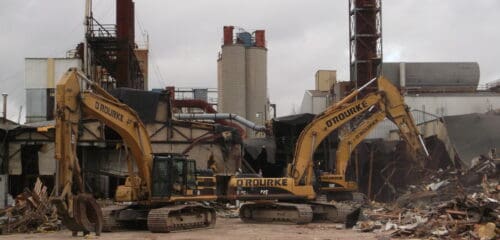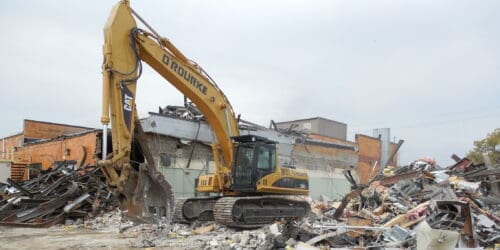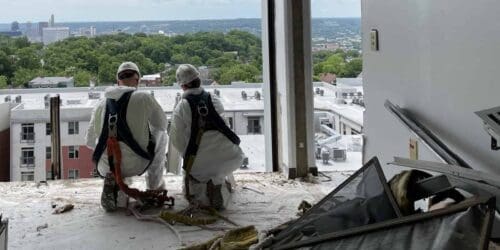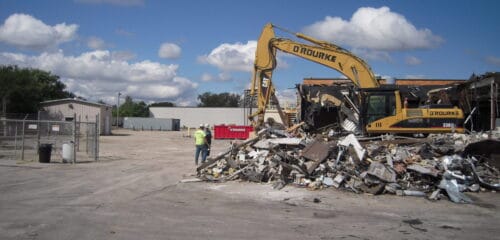Demolition work entails much more than just the act of tearing down buildings. It also refers to the precision, safety, and deliberate preparation that each project needs. When demolishing a commercial building, such as a vast industrial complex, each phase of the demolition project plays an integral part in making it successful, smooth, and secure for the property and the surrounding areas. This short guide will discuss the detailed aspects of arranging a demolition operation to understand the critical elements and methods – feel free to contact our team at O’ROURKE with any questions!

Demolition Plans Require Many Steps
A demolition project is a complex endeavor requiring proper planning and execution. It’s not a one-size-fits-all process; each project is unique, demanding a tailored approach to address specific challenges and requirements. The success of any demolition project hinges on careful preparation and a thorough understanding of the different stages involved.
What Goes Into Planning a Demolition Project?
As stated above, full-service demolition isn’t just about smashing concrete and steel; it’s a carefully orchestrated dance of safety protocols, building codes, environmental considerations, and meticulous strategizing. From securing the necessary permits to coordinating with utility companies, every detail is critical. So, what exactly goes into planning a demolition project? Read on as we dive into each aspect of the demolition process!
Survey the Building and Surrounding Property
Before demolishing a building, a thorough survey of the structure and the building site must be carried out. The initial survey is to determine the structural condition and stability of the building, establish hazardous construction materials, and assess the proximity of other neighboring construction and utilities. This is also done to devise a plan detailing the best methods and measures to demolish the building. Additionally, the building survey includes accurate mapping of the site’s topography to ensure there is no disruption of any essential underground utility during the structure’s demolition.
Determine the Best Demolition Method for the Building
Choosing the proper demolition method is crucial and depends on various factors, such as the building’s size, structure, location, and the materials used in its construction. Several demolition methods include implosion, high-reach dismantlement, wrecking balls, selective demolition, and many more. Each method has its own advantages and challenges. For instance, implosion might be suitable for tall buildings in an open area, whereas selective demolition might be better for structures in densely populated areas where precision is paramount. The chosen method will significantly impact the project’s timeline, cost, and safety measures.

Crafting a Demolition Plan
Crafting a complete demolition plan is at the heart and soul of the entire process, where every step needs to be meticulously mapped out to ensure precision, safety, and efficiency. This isn’t just about swinging a wrecking ball—it’s about understanding the structure’s anatomy, identifying potential hazards, and strategizing the sequence of actions down to the finest detail!
Secure the Necessary Permits
Demolition projects are subject to numerous regulations and require legal permits before work can commence. These permits ensure that all demolition companies comply with local, state, and federal laws. Obtaining the necessary permits can be time-consuming, often involving detailed documentation and inspections by regulatory bodies. It is essential to start this process early to avoid delays in the project. Permits typically cover safety measures, environmental impact, and waste disposal, among other factors.
Account for Environmental Considerations
Environmental factors are important to consider when planning a building demolition. The process can lead to a large amount of dust and debris and make a lot of noise that can affect the nearby environment. Thus, it is essential to reduce such adverse effects, when possible, by recycling most of the materials and making sure that hazardous materials are appropriately disposed of, preventing contamination of nearby land and water.

Removal of Hazardous Materials
First, before dismantling can be carried out, all dangerous substances that workers and neighbors could be exposed to during the demolition should be removed from the building. These substances, including asbestos, lead, mold, and other dangerous materials, are dangerous for the life and health of employees and the community at large. Expert demo teams, like ours at O’ROURKE, can carry out the dismantling work and regulate the removal and transport of hazardous materials. The importance of eliminating dangerous substances is associated with legal compliance and the necessity to protect the environment and surrounding communities!
Enforce Safety Measures (Crew, Surrounding Areas, etc.)
Safety is always the top priority in any demolition project. It involves protecting the workers, the surrounding community, and properties alike. This requires comprehensive safety measures, including providing proper protective equipment for workers, setting up exclusion zones, and implementing rigorous safety protocols for the demolition. Regular safety training and drills should be conducted to prepare the crew for any emergencies. Clear communication channels should also be established to ensure everyone on site knows the proper procedures and potential hazards!
Perform the Actual Demolition
Now comes the moment of truth: the actual demo can begin! Months of meticulous planning and strategizing culminate in a powerful, orchestrated demolition. From controlled implosions to the systematic deconstruction of towering skyscrapers, performing the actual demolition demands cohesion with heavy machinery, expert operators, and real-time adjustments. It’s a high-stakes operation where precision and brute force collide, transforming structures into rubble while ensuring safety and minimizing disruption.
Properly Transport and Dispose of Demolished Waste
Tons of waste and debris is produced during a demolition project, and a large part must be transported and disposed of correctly. To that end, adequate waste management practices must be in place. Some debris can be recycled, and some cannot; further division of the previously identified waste is also necessary due to environmental concerns. Hazardous waste must be separated and disposed of correctly as well!

O’ROURKE is a Trusted Name in the Demolition Industry
In the world of demolition, O’ROURKE is proud to be a leader in the industry, regarded for our skills, consistency, and dedication to safety! We have over 60 years of experience and have worked on countless projects across the US, ranging from minor residential demolition to enormous industrial dismantling. Because of our extensive expertise and utilization of cutting-edge techniques, O’ROURKE remains a top-rated partner for any demolition!
Over 60 Years of Experience with All Kinds of Projects
O’ROURKE’s rich history in demolition spans six decades, during which we have tackled projects of varying complexities and scales. Our experience has equipped us with the skills and insights to manage any demolition project efficiently! Whether it’s demo on a high-rise building in downtown Columbus or a sprawling Cincinnati industrial plant, our team can deliver exceptional results tailored to the specific needs of each project.
Top-Rated Demolition Solutions for Any Method
O’ROURKE is proud to offer a comprehensive range of demolition solutions, utilizing the latest technology and methodologies. From implosion to selective demolition, we are adept at choosing the most suitable method for each project.
Our team of experts can carefully evaluate the unique aspects of every demolition job and implement the best strategies to ensure safety, efficiency, and minimal disruption to the surrounding areas!
Our Dedication to Safety and Integrity
Safety and integrity are the cornerstones of our operation. O’ROURKE proudly adheres to the highest safety standards and ethical practices, ensuring every project is conducted responsibly and transparently. Our commitment to safety extends beyond regulatory compliance, encompassing comprehensive safety training for their crew, regular site inspections, and proactive risk management. This dedication to maintaining a safe and ethical work environment earned O’ROURKE a stellar reputation in the industry!
O’ROURKE’s Past Projects Across the Country
Our impressive portfolio of past projects showcases our ability to handle demolition tasks of any scale and complexity. Our team has completed projects nationwide in various locations, each presenting unique challenges!
